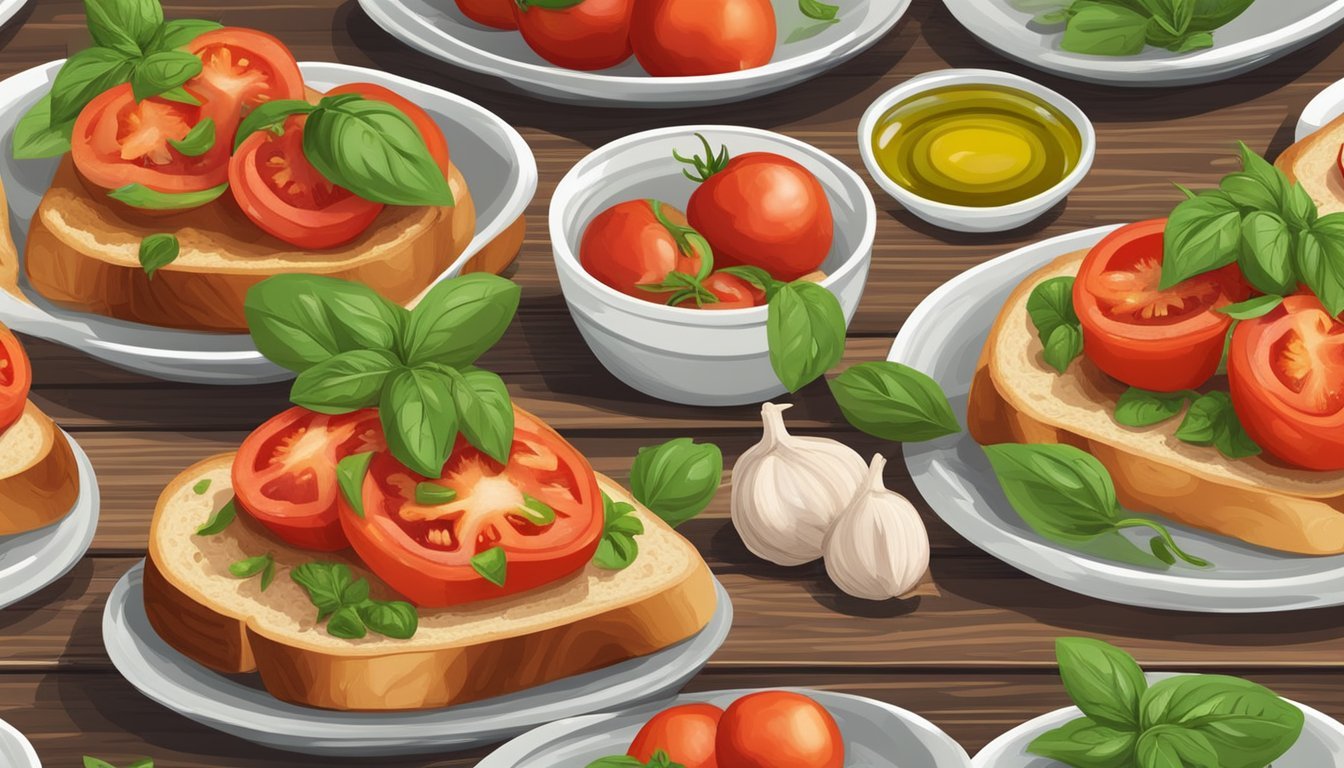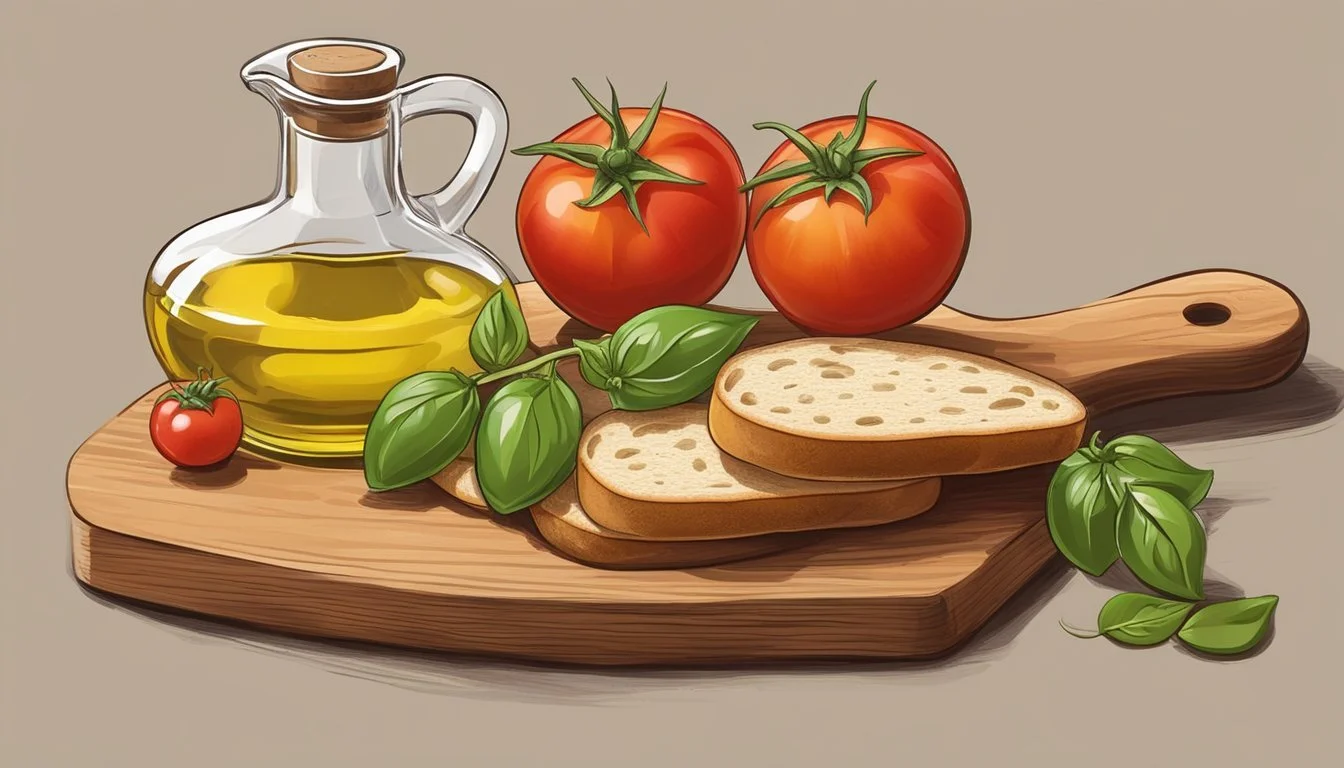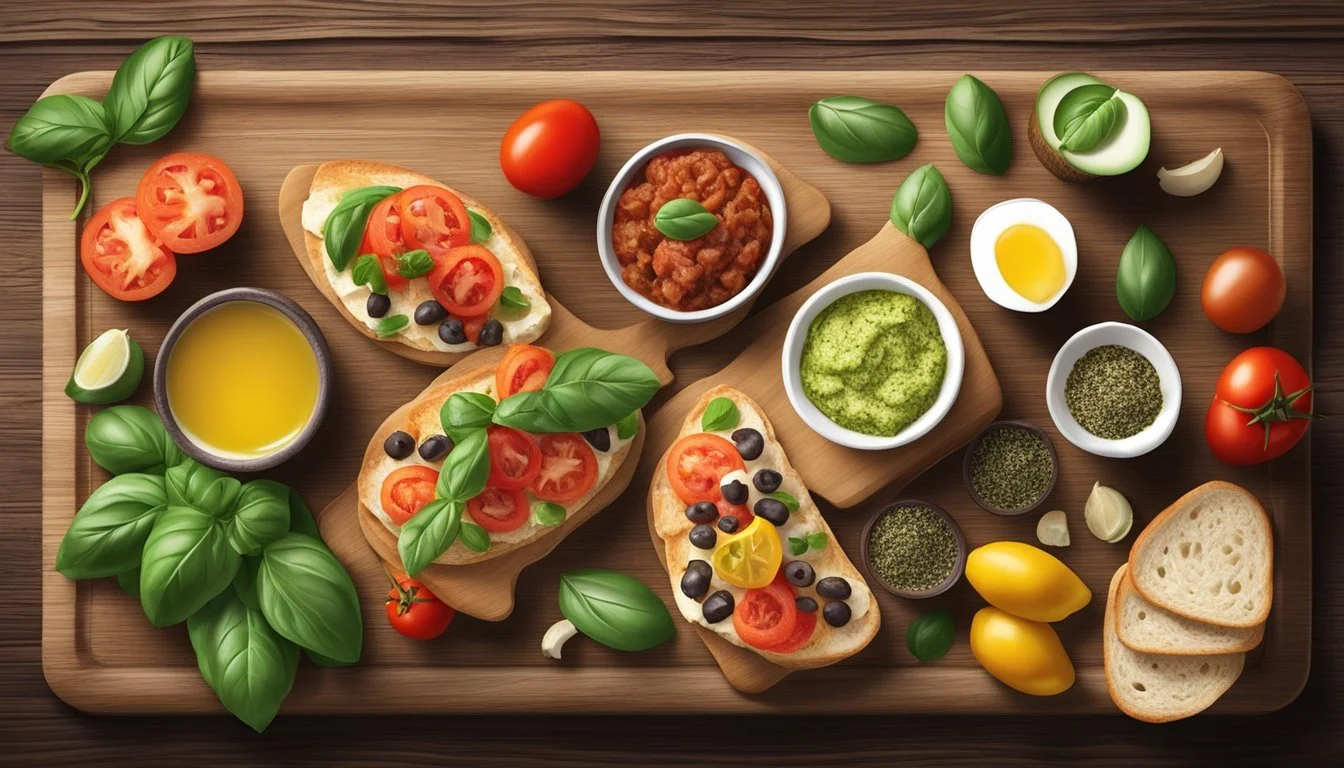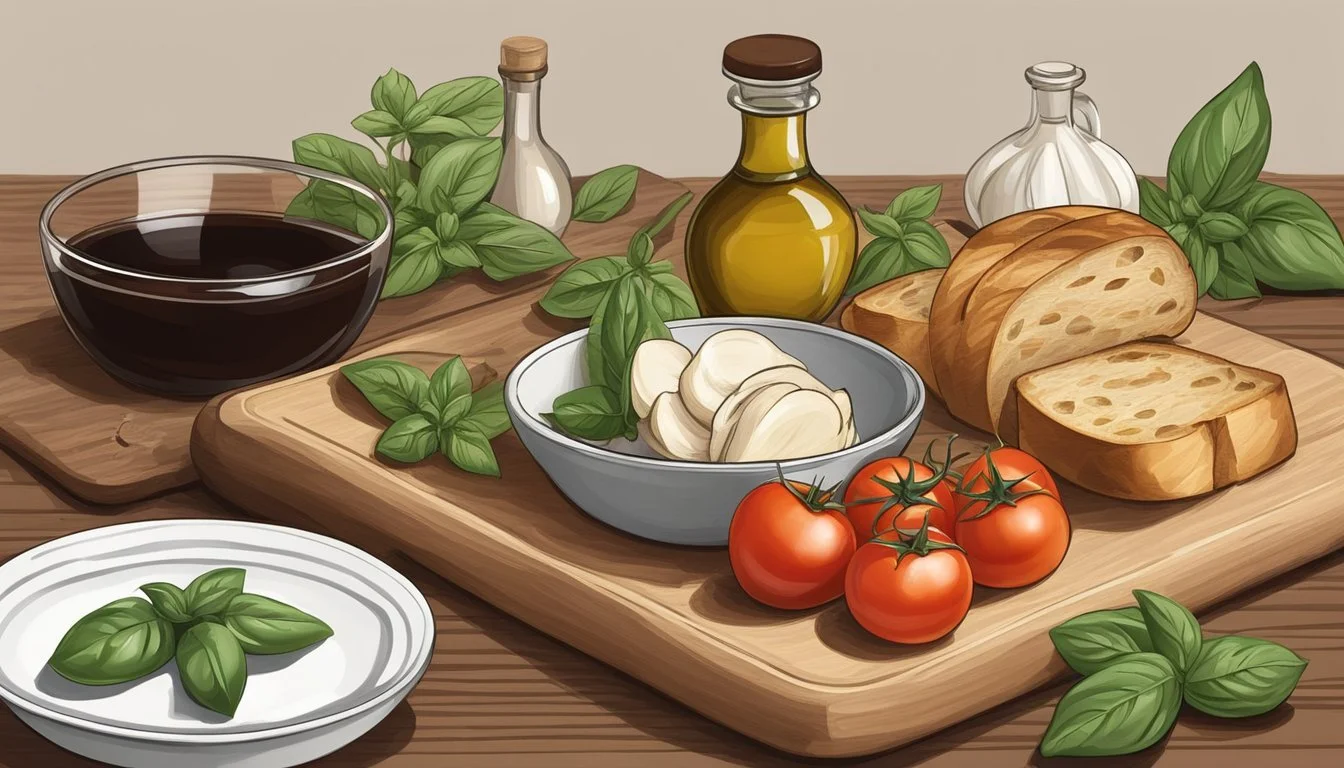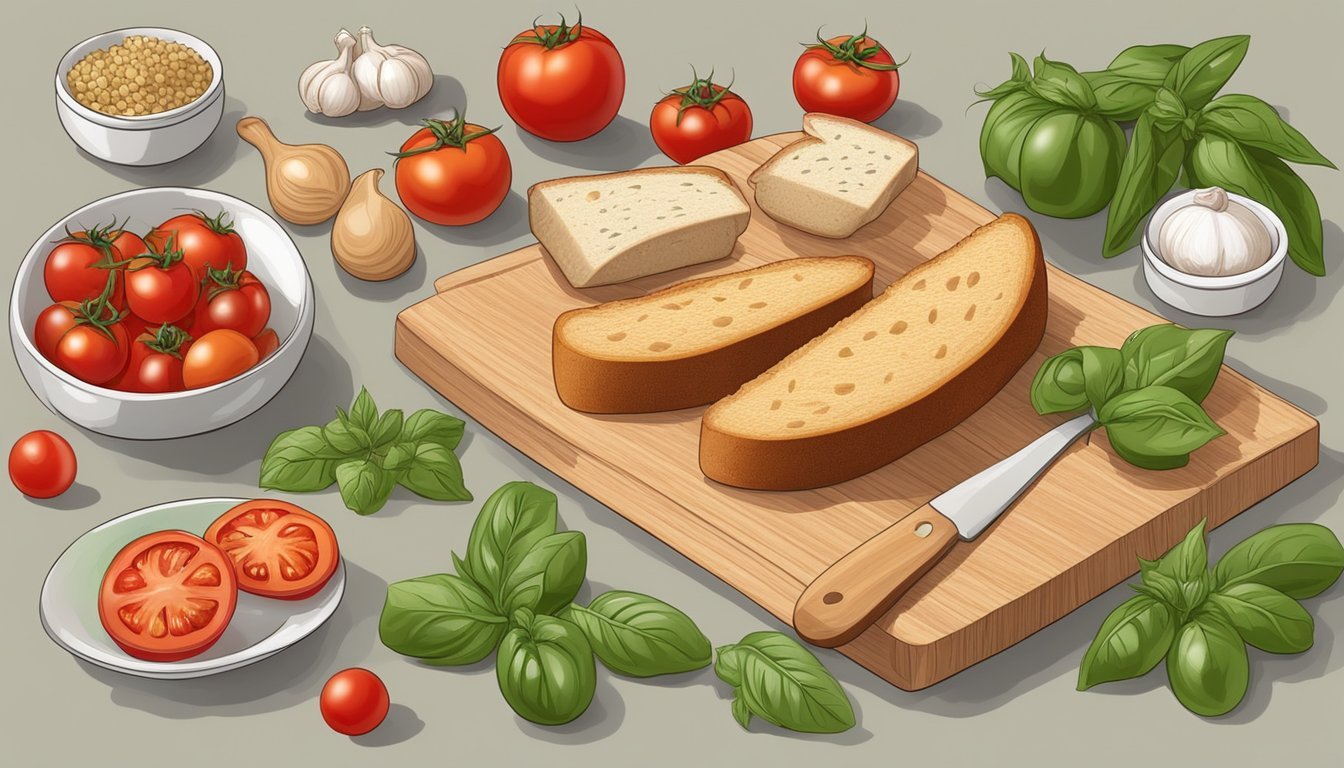Bruschetta Substitutes
Top Alternatives for Your Italian Appetizer
Bruschetta, a classic Italian starter, traditionally consists of grilled bread rubbed with garlic and topped with a combination of fresh tomato, basil, olive oil, and sometimes cheese or other vegetables. While its simplicity is a hallmark, bruschetta offers room for creativity, particularly when it comes to the bread base. For those following specific dietary regimens or simply in search of variety, there are numerous alternatives to the classic bruschetta bread that can offer different flavors, textures, and nutritional profiles.
In place of the typical baguette or sourdough, options like gluten-free almond flour bread, low-carb Joseph's lavash bread, or even grain-free cheese chips provide a suitable canvas for bruschetta toppings. These alternatives cater to dietary restrictions such as keto, gluten-free, or low-carb while still preserving the essence of this Italian favorite. Moreover, non-traditional substitutes like sliced and seasoned vegetables, including eggplants, sweet potatoes, and mushrooms, can be roasted to achieve a satisfying base that is both vegan and paleo-friendly. These variations not only accommodate dietary needs but also introduce an array of textures and flavors that can enrich the bruschetta experience.
Understanding Bruschetta
Bruschetta is a traditional Italian appetizer that has gained global popularity for its simple yet flavorful combination of ingredients.
History and Origin
Bruschetta, pronounced 'bruˈsketta', originates from Italy, with roots dating back to ancient Rome. Laborers would use their bread to bring out the flavor of freshly harvested vegetables. It was a practical way for them to eat while working in the fields. Over time, it evolved into a refined dish that embodies the essence of Italian cuisine, highlighting fresh, quality ingredients.
Classic Bruschetta Ingredients
The simplicity of bruschetta allows each ingredient to shine, and traditionally, these ingredients include:
Bread: A crusty Italian baguette or ciabatta, toasted to perfection.
Tomatoes: Ripe, juicy tomatoes, diced and often marinated in olive oil and herbs.
Olive Oil: High-quality extra virgin olive oil drizzled for a rich, fruity flavor.
Garlic: Fresh garlic cloves, typically rubbed on the toasted bread.
Basil: Fresh basil leaves, providing a fragrant aroma and a citrusy, peppery flavor.
These ingredients are combined to create a colorful and flavorful mix, typically layered atop the bread for a blend of textures and tastes.
Alternate Breads and Bases
In exploring substitutes for traditional bruschetta bases, the focus is on gluten-free options and whole grain alternatives that offer diverse textures and flavors while maintaining the spirit of the classic Italian appetizer.
Gluten-Free Options
Those requiring gluten-free alternatives can find satisfaction in a variety of bases. Crackers serve as a light, crisp foundation and come in gluten-free varieties. They can mirror the traditional bite of bruschetta while providing a different texture. For a homemade approach, gluten-free breads, which often use rice or almond flour, can be toasted to achieve a satisfying crunch and topped with traditional bruschetta mixtures.
Crackers: Various gluten-free crackers like rice, almond, or multi-seed
Gluten-Free Breads: Many brands offer ciabatta-style gluten-free bread
Hearty Grain Alternatives
A multitude of whole grain breads can be used instead of the typical white baguette or ciabatta. Whole wheat baguettes, with their nutty flavor and robust texture, offer a heartier bite and additional nutritional benefits. They can be sliced and toasted, creating the perfect sized pieces for a hearty version of bruschetta. Other artisanal breads like sourdough or multigrain loaves also make excellent options, complementing the bruschetta's toppings with their tangy or complex flavor profiles.
Whole Wheat Baguette Slices: Slice and toast for a healthier alternative
Multigrain and Sourdough Loaves: Offer a chewy texture and rich flavors
Tomato Substitutes
When making bruschetta, tomatoes are often celebrated for their ripe, juicy qualities. However, there are a variety of substitutes that maintain the dish's freshness and flavor profile. These alternatives are especially useful when tomatoes are out of season or for those looking to add a unique twist to their bruschetta.
Fruit-Based Alternatives
Mango: A ripe mango can mimic the juicy sweetness of tomatoes. It can be diced to provide the same burst of color and freshness.
Tamarind Paste: Although less common, tamarind paste offers a tangy flavor that works well in bruschetta, replicating the acidity of ripe tomatoes, particularly in curry-influenced variations.
Vegetable-Based Variations
Bell Peppers: These can be used raw or roasted, with red peppers offering a sweet taste similar to ripe heirloom tomatoes.
Eggplant: When roasted and diced, eggplant lends a rich, savory component that stands in for the meatiness of tomatoes.
Zucchini: Fresh zucchini, either sliced or diced, can be used for a mild, crisp substitute, echoing the texture of ripe Roma or cherry tomatoes.
Herbs and Flavorings
The right selection of herbs and flavorings can transform bruschetta from a simple snack into a culinary delight. Focusing on fresh ingredients and proper seasoning will ensure a balance of flavors that complements the bread and toppings.
Herb Varieties
Fresh basil is a quintessential herb in traditional bruschetta, offering a sweet, peppery flavor that pairs excellently with the juicy tomatoes. For a twist, one might consider using oregano, which imparts a slightly bitter, earthy taste that can add depth to the appetizer.
Fresh basil: A staple in bruschetta for its bright and aromatic qualities.
Oregano: Can be used fresh or dried for a more robust herbaceous note.
Spices and Seasonings
When it comes to enhancing the flavors of bruschetta, the role of spices and seasonings cannot be overstated. Kosher salt and sea salt are preferred for their ability to draw out the natural flavors of the other ingredients without imparting a metallic taste.
Salt: Can be kosher or sea salt, used to enhance the natural flavors of the bruschetta.
Black pepper: Freshly ground black pepper adds a subtle heat that complements the freshness of the herbs.
Spice: While not traditionally spicy, a pinch of red pepper flakes can be added for those preferring a bit of heat.
One must ensure that spices are used judiciously to avoid overpowering the delicate flavors of the other bruschetta components. The freshness of the herbs and the quality of the seasonings are pivotal for achieving the perfect blend of flavors.
Toppings and Additions
Bruschetta's beauty lies in its versatility, offering a canvas for a range of toppings. From classic cheese options to protein enhancements and gourmet toppings, these additions can elevate the humble bruschetta to a flavor-packed delight.
Cheese Options
A variety of cheeses complement the crispness of bruschetta. Traditional mozzarella enhances the topping with its creamy texture and mild flavor. It pairs well with tomato-based toppings, creating a fusion reminiscent of a caprese salad. Another classic is Parmesan cheese, offering a sharp, salty note often shaved over the bruschetta for a refined finish. For those seeking a richer consistency, ricotta serves as a smooth and slightly sweet foundation for other ingredients. For a dairy-free alternative, vegan Parmesan made from nutritional yeast provides a similar umami effect.
Proteins Enhancements
Incorporating proteins can turn bruschetta from a simple appetizer into a more substantial offering. Cured meat like prosciutto adds a savory element that cuts through the richness of cheeses like mozzarella. Those adhering to a vegetarian diet can opt for sliced avocado, delivering a creamy texture and a boost of heart-healthy fats.
Gourmet Toppings
Elevating bruschetta with gourmet toppings offers a luxurious experience. Pesto, with its bold basil and pine nut flavors, can serve as a spread that introduces a herbal freshness to the palate. Additional upscale options include sun-dried tomatoes, artichokes, or roasted peppers, providing bursts of intense flavor and a visually appealing addition to the simple bread base.
Dressings and Oils
When preparing bruschetta, the choice of dressings and oils can significantly influence the flavor profile of the dish.
Olive oil is the traditional base for bruschetta toppings. It offers a rich taste that complements the acidity of tomatoes. For a more distinguished flavor, extra virgin olive oil is preferred due to its fruitier notes and greater depth of character.
Balsamic vinegar adds a complex sweetness and a touch of acidity which can enhance the bruschetta's overall taste. This can either be used in its pure form or as a balsamic glaze, which is a reduced and thickened version, providing a more concentrated flavor and a sticky texture ideal for drizzling.
On the other hand, red wine vinegar serves as a tangy alternative to balsamic. It provides a sharper vinegar kick which can cut through the richness of the olive oil, giving bruschetta a more balanced taste profile.
Here's a brief guide on how to use these ingredients:
Dressing/Oil Description Usage Tips Olive Oil A staple for bruschetta, rich and smooth. Brush on bread before toasting, mix with tomatoes. Extra Virgin Olive Oil Fruitier than regular olive oil. Use sparingly for topping or dressing. Balsamic Vinegar Sweet and acidic. Combine with tomatoes, or drizzle after plating. Balsamic Glaze Thick and concentrated. Drizzle on top for a glossy finish and flavor boost. Red Wine Vinegar Sharp and tangy. Mix with tomatoes for a zesty twist.
For a health-conscious alternative without oil, a variety of oil-free dressings can bring moisture and flavor to bruschetta such as those with a peanut or tahini base, providing a creamy texture without the need for traditional oils.
Serving and Presentation
When serving Bruschetta, presentation is key to enhancing its appeal as an Italian appetizer. Attention to detail in plating and serving sizes can elevate Bruschetta from a simple antipasto to the star of a party platter.
Plating Suggestions
One might consider arranging Bruschetta on a large platter in rows or a spiral pattern to showcase the vibrant colors and variety. Garnishing with a sprig of basil or a drizzle of glaze can add a touch of elegance. Use a neutral-colored platter to let the colors of the tomatoes, basil, and cheese stand out.
Suggested Garnishes:
Whole basil leaves
Balsamic glaze drizzle
A dusting of finely grated Parmesan
It is also effective to serve individual portions on small plates or as part of a mixed antipasto plate, highlighting the Bruschetta among other Italian specialties.
Serving Sizes
Bruschetta is typically served as a small appetizer. For a party, one can estimate about 3-4 pieces per person.
Type of Gathering Suggested Servings Small get-together 15-20 pieces Large party 30-50 pieces or more, depending on the total number of appetizers (What wine goes well with appetizers?) provided
The key is to provide enough to whet the appetite without overshadowing the main course, keeping in mind that for larger gatherings, variety is appreciated.
Recipe Variations
Bruschetta is celebrated for its simplicity and versatility, easily adaptable with various toppings and substitutions to fit a multitude of international palates and dietary requirements.
International Flavors
One can embark on a global culinary journey with bruschetta by incorporating flavors from around the world. For a Mediterranean twist, one might use feta and olives, while a Mexican-themed bruschetta could feature black beans and avocado. An Asian fusion variation might include a topping of diced mango, cucumber, and a splash of soy sauce or sesame oil.
Mediterranean: Feta, olives, cucumber
Mexican: Black beans, avocado, corn, cilantro
Asian: Mango, cucumber, soy sauce, sesame oil
Diet-Specific Recipes
Dietary restrictions or preferences needn't prevent anyone from enjoying bruschetta. A gluten-free version could substitute traditional bread with gluten-free alternatives. Those following a vegan lifestyle can enjoy bruschetta by omitting cheese or by using plant-based cheese substitutes. For those on keto, paleo, or Whole30 diets, slices of fresh cucumber or mini bell peppers provide a crisp, grain-free base.
Gluten-Free: Use gluten-free bread or crackers.
Vegan: Replace cheese with vegan cheese or nutritional yeast.
Keto/Paleo/Whole30: Cucumber slices or mini bell peppers instead of bread.
Preparation and Cooking Tips
When making substitutions in bruschetta, one can still ensure that the resulting dish maintains the essence of the traditional appetizer. The focus lies in the prep time, cook time, and ensuring freshness.
Make-Ahead Techniques
For those looking to prepare bruschetta in advance, certain components lend themselves to pre-preparation. Dicing fresh tomatoes and allowing them to marinate in olive oil, balsamic vinegar, and seasonings can enhance their flavor. They should, however, only sit for a few hours max to maintain their freshness.
Prep time before marinating: 10-15 minutes
Marinating time: Ideally 30 minutes to 2 hours
Cooking Methods
The bread base of bruschetta can be cooked in different ways. Traditionally, bread is grilled to achieve a rustic char and flavor. However, when a grill isn't available, an oven preheated to 400 degrees F can be employed to toast the bread until golden, which typically takes about 5 to 8 minutes. Meanwhile, if one's preference leans towards a softer texture, toasting on a stovetop or a lower oven temperature can be considered.
Grill cook time: 1-3 minutes per side
Oven cook time: 5-8 minutes total
Storage and Freshness
Bruschetta is best enjoyed when all ingredients are fresh. However, leftover toppings can be stored in an airtight container in the refrigerator for up to 2 days. The bread should always be prepared fresh and is not ideal for extended storage as it loses its crispy texture.
Storage: Up to 2 days for toppings in the fridge
Freshness: Prepare the bread on the day of serving to maintain the ideal texture
Social Media and Community
In the context of bruschetta substitutes, social media platforms like Instagram and Facebook have become pivotal for sharing creative ideas and gathering community feedback.
Sharing and Inspiration
Instagram serves as a treasure trove for those seeking inspiration for bruschetta substitutes. Users often post high-resolution images of their culinary experiments, using hashtags such as #KetoRecipes or #VeganEats to showcase alternatives like sliced eggplant or potato bases. These visual postings act as a catalyst for others to try new combinations and share their own creations, effectively creating a continuous loop of culinary creativity.
Examples of popular substitutes found on Instagram:
Sliced eggplant or sweet potatoes as a base
Gluten-free bread alternatives for those with dietary restrictions
Unconventional toppings like mushrooms or dairy-free cheese
Reviews and Feedback
Facebook community groups are a go-to for individuals seeking reviews and feedback on their bruschetta substitutes. Members of these communities candidly share their experiences, often recommending the best types of cheeses or bread alternatives. Moreover, they provide critical feedback that can help home cooks refine their recipes.
Feedback culture on Facebook includes:
Star ratings or like counts that give instant visual feedback on popularity
Comment sections where details about taste and texture are discussed
Reviews also come in the form of personal blogs or community pages, where lengthy discussions about the success of various substitutes can influence others' decisions in choosing ingredients or techniques.
Accompaniments and Pairings
When selecting accompaniments and pairings for bruschetta, it's essential to consider the balance of flavors and how each component complements the other. Whether one is planning for a light snack or a full dinner, thoughtful choices in beverages and complementary dishes can elevate the bruschetta experience.
Wine and Beverages
Wine Pairings:
For a classic Italian appetizer like bruschetta, a crisp and acidic white wine such as Pinot Grigio pairs beautifully, cutting through the richness of the olive oil and cheese.
In the summer, a chilled glass of rosé provides a refreshing counterpoint to the dish's bold tomato and basil flavors.
Other Beverages:
For non-alcoholic options, sparkling water with a twist of lemon or lime complements the dish without overpowering it.
A light-bodied beer, served cold, is also a suitable choice for more casual settings or parties.
Complementary Dishes
For Dinner:
Pasta: Consider serving a simple Aglio e Olio or Pasta Arrabiata, as their garlic and spice pair well with the bruschetta's robust flavors.
Protein: Grilled chicken breast or a tender steak can serve as a hearty accompaniment, especially when seasoned with herbs that echo the bruschetta's Italian roots.
For Snacks or Parties:
A Caprese salad—with its fresh tomatoes, mozzarella, and basil—mirrors the flavors of the bruschetta and serves as a light, yet satisfying option.
For a tapas-style spread, include Italian meat and cheese platters, or prosciutto and melon skewers for a sweet and savory contrast.
Alternative Dietary Adaptations
Bruschetta, traditionally an Italian appetizer featuring tomatoes atop grilled bread, can be adapted for various dietary needs without compromising on flavor. These adaptations cater to both plant-based diets as well as low-carbohydrate lifestyles.
Vegetarian and Vegan Options
Vegetarians can enjoy bruschetta in its classic form, substituting cheese with plant-based versions if desired. Vegans, on the other hand, may opt for toppings such as tomato and basil or zucchini and white beans, ensuring no animal products are used. For an umami flavor, sliced mushrooms can be seasoned and roasted, then used in place of traditional toppings.
List of Vegan Toppings:
Cherry tomatoes, basil, and balsamic glaze
Roasted red peppers and artichoke
White beans, garlic, lemon juice, and herbs
Avocado, lime, and cilantro
Eggplant and sweet potatoes are excellent bread substitutes for a vegan bruschetta recipe. These vegetables can be sliced, seasoned, and baked until they offer a sturdy base for the delicious toppings.
Low-Carb and Keto Approaches
For individuals following a low-carb or ketogenic diet, bread is often the first ingredient to eliminate. They can replace the bread with a variety of non-starchy alternatives that provide a similar texture and surface for the toppings.
Keto-Friendly Bases:
Sliced and baked eggplant
Roasted mushroom caps
Crisp lettuce leaves or endive boats
Grilled zucchini slices
Each base offers a unique taste and nutritional profile, while still complimenting the classic bruschetta toppings. Crackers made from almond flour or cheese crisps can also provide a satisfying crunch. When crafting a keto bruschetta recipe, additional care is taken to ensure that all toppings align with the dietary restrictions, using high-fat and low-carb components such as avocado and olives.
Substitute Ingredients and Their Impact
When customizing Bruschetta, selecting substitute ingredients can profoundly affect the dish's taste, texture, and nutritional profile. It's essential to consider how each element complements or alters the original recipe.
Tomatoes: Typically, fresh, ripe tomatoes are ideal for their flavorful, juicy qualities. However, one can opt for grape or cherry tomatoes when larger varieties aren't in season. They offer a sweeter, more concentrated taste and maintain a firm texture after cutting.
Bread: Traditional Bruschetta uses crusty Italian bread, like Ciabatta. For a twist, using sweet potatoes, potatoes, or even zucchini slices roasted in the oven can offer a nutritious and gluten-free base. These vegetables should be sliced and brushed with olive oil before baking to achieve a firm texture that holds toppings well.
Toppings: Typically, Bruschetta is topped with a combination of tomatoes, garlic, and basil. Substitutes like beans can add a unique flavor and offer a protein boost. Diced onion or red onion can add sharpness and crunch, contrasting with the other ingredients' softness.
Spreads: In place of olive oil and garlic, spreads like hummus or guacamole can serve as creamy bases, transforming Bruschetta into a fusion dish. These spreads contribute to a richer mouthfeel and introduce different flavor profiles.
Flavor Enhancers: Fresh ingredients provide zest, but when unavailable, one can use leftovers that match the expected flavor profile. For instance, leftover roasted vegetables could add depth to the topping mixture.
By considering how substitutes interact, one can create a Bruschetta dish that is both innovative and respectful of its origins.
FAQs and Common Concerns
This section addresses frequently asked questions and common concerns regarding culinary techniques, ingredient selection, and health and allergy considerations when making bruschetta.
Culinary Techniques
When creating tomato bruschetta, the technique for cutting basil is important. One should use the chiffonade method to ensure fine, ribbon-like strips that will distribute flavor more evenly. If freezing is an option one is considering, it is generally not advisable for bruschetta, as the fresh ingredients may become soggy upon thawing.
Ingredient Selection
Selecting the correct ingredients is crucial for the ideal bruschetta. High-quality olive oil is a non-negotiable, as it forms the base of the flavor profile. When choosing tomatoes, one must ensure they are ripe and juicy. If dealing with out-of-season or less flavorful tomatoes, consider enhancing them with ingredients like garlic or balsamic vinegar to amplify the taste.
Health and Allergies
Bruschetta is a light and healthy appetizer option; however, individuals with certain dietary restrictions should consider substitutions. For instance, those with gluten sensitivities can opt for gluten-free bread options. Additionally, if someone has an allergy to olive oil, substituting it with an alternative oil that has a similar flavor profile, such as avocado oil, can be effective.
Conclusion
Exploring substitutes for traditional bruschetta ingredients can invigorate this classic appetizer with new flavors and textures. It is essential, however, to balance creativity with a respect for the dish’s simple and fresh essence. Cheeses such as Parmigiano-Reggiano and Mozzarella di Bufala have been affirmed as excellent choices for their ability to complement the foundational tomato and basil components.
For those seeking alternatives to standard bruschetta foundations, vegetables like eggplant, sweet potatoes, and mushrooms provide a canvas for the classic toppings, while adhering to various dietary requirements such as keto, paleo, or vegan.
In the realm of dressings and acids, a well-mixed combination of olive oil and a substitute for balsamic vinegar, if needed, can enhance the profile of the dish without overshadowing the primary ingredients.
Lastly, although experimenting is encouraged, chefs should always strive for a harmonious blend of ingredients that pays homage to the dish's Italian roots. They must consider how each component interacts to create a satisfying, cohesive experience.
Preferred Cheeses Plant-Based Options Dressing Alternatives Parmigiano-Reggiano Eggplant Olive oil Mozzarella di Bufala Sweet Potatoes Balsamic Vinegar Substitute Mushrooms
Embracing these suggestions will lead to a deliciously crafted bruschetta that invites guests to savor a timeless dish with a personalized twist.

